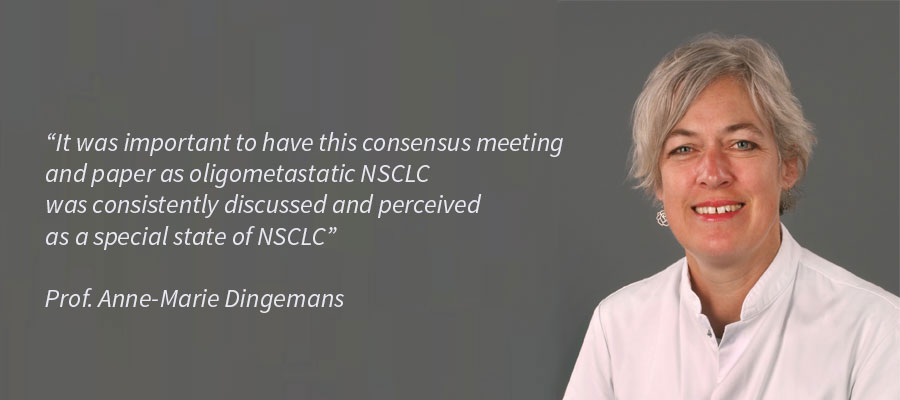EORTC brings together experts from medical societies to compile a consensus definition for synchronous oligometastatic non small cell lung cancer
18 Sep 2019
A consensus report1 was published in the Journal of Thoracic Oncology on the definition of synchronous oligometastatic non small cell lung cancer (NSCLC). Thirty-five multidisciplinary thoracic oncology experts, from all over Europe, compiled this definition. These experts, brought together by EORTC Lung Cancer Group (EORTC LCG), were representatives from International Association for the Study of Lung Cancer (IASLC), European Respiratory Society (ERS), European Society for Radiotherapy and Oncology (ESTRO), European Society of Medical Oncology (ESMO) as well as EORTC Radiation Oncology Group (EORTC ROG).
“We felt it was important to have this consensus meeting and paper as oligometastatic NSCLC was consistently discussed at lung cancer conferences and perceived as a special state of NSCLC,” said Professor Anne-Marie Dingemans, from Department of Pulmonary diseases, Erasmus Medical Center, Rotterdam, in the Netherlands and lead author of the report. “But a clear definition was lacking. We felt, as EORTC-LCG, at least for future clinical trials, a uniform definition was needed in order to speak the same language when comparing clinical trial data.”
The concept of oligometastasis was described in 1995, where it was proposed that these metastatic patients could benefit from local radical treatment. Several studies showed that this treatment was beneficial to NSCLC patients with metastatic cancer presented in up to five sites of their body. In the last few years, the treatment of synchronous oligometastatic NSCLC has evolved and this disease has been addressed as special treatment in the ESMO and NCCN guidelines. However, different definitions and staging procedures have been used in clinical research.
To produce the definition, a preparatory phase was carried out, in which a survey2 was sent to gain insights into the dilemmas of the definition and staging of the disease. This survey was sent to the consensus group as well as national societies and members of the EORTC LCG and ROG. There was also a systematic review from 1996 to 2017 on definitions used in publications.
In addition, ten real life cases of patients with synchronous oligometastatic NSCLC, defined as less than 5 metastases, were sent to members of the consensus group and were asked to discuss the cases in their multidisciplinary teams to consider whether a case was oligometastatic and if it was, the team was asked to outline the treatment option. These responses were compared with results from 2013 where the same exercise was undertaken.
423 physicians from 34 countries completed the survey, the answers helped to formulate the questions for the consensus meeting. The systematic review3 identified 1125 abstracts of which 21 papers were eligible for the systematic analysis. In total 1215 patients with the disease were included in these papers; there was variation from 1 to 8 number of metastasis allowed in the definition of oligometastatic NSCLC, however the majority of papers allowed, less than 5. For the real cases, 62% discussed the cases. There was 100% consensus on the diagnosis of oligometastatic disease in one case, 3 cases had over 90% consensus and for the rest, the consensus was between 38% to 69%. These results were presented and discussed at the consensus meeting.
“It was a very interesting meeting, because we had a lot of discussions, everyone had their own opinion, showing that high level of evidence is lacking” said Professor Dingemans. “However, a consensus was met.”
In brief, the definition is defined as:
1. Synchronous oligometastatic NSCLC is relevant when a radical treatment is technically feasible with acceptable toxicity, with all sites being amenable to local treatment modality that may modify the course of the disease and be considered as an opportunity for long-term disease control.
2. Definition of oligometastatic NSCLC
2.1 Maximum number of metastases and organs
The maximum number of metastases/organs involved depends on the possibility of offering a radical intent treatment strategy. Based on the systematic review, a maximum of 5 metastases and 3 organs was agreed on. The presence of diffuse serosal metastases or bone marrow involvement excludes cases from this definition.
2.2 Nature of organs involved
All organs are allowed, except diffuse serosal metastases (meningeal, pericardial, pleural, mesenteric) as well as bone marrow involvement as these cannot be treated with radical intent.
2.3 Pulmonary metastases
Pulmonary metastases are counted as a metastatic site.
2.4 Mediastinal involvement
Mediastinal lymph nodes should not count as a metastatic site; mediastinal lymph nodes must be considered as regional disease. However, mediastinal lymph node involvement is of importance in determining if radical local treatment of the primary may be applied.
2.5 Data to be collected in future trials
Other definition questions were discussed (use of risk classification groups, total tumour volume, there was consensus that these finding are of interest but that there is a lack of data to formulate a statement. It was recommended that data should be collected in future trials and registries to evaluate the usefulness of risk classification groups and total tumour volume.
3. Staging
3.1 Imaging work-up
18F-FDG-PET-CT and brain imaging are mandatory. For brain imaging, MRI is preferred.
3.2 Mediastinal staging
Mediastinal staging with 18F-FDG-PET-CT is needed, with pathological confirmation required if this influences treatment strategy.
3.3 Pathological confirmation
Pathological confirmation of at least one metastasis is required unless the MDT decides that the risk outweighs the benefit.
3.4 Solitary metastasis
In addition to sections 3.2-3.3, for a solitary metastasis on 18F-FDG-PET, in specific cases additional work-up is advised. When the liver is the only site of oligometastatic disease a dedicated MRI of the liver is advised, and if a solitary pleural metastasis is suspected on imaging, then thoracoscopy and dedicated biopsies of other ipsilateral pleural sites are recommended as multifocal disease is often evidenced in this context during procedure. Of note, pleural malignant effusion is not considered amenable to radical treatment to date.
“The main goal of the definition is for clinical research, however I think it is important that clinicians are aware of the different definitions used in clinical trials and in our paper we state all discussion points,” concludes Professor Dingemans.
“There is an increasing interest in the oligometastatic disease and, as a result, a growing number of trials with heterogeneous definitions,” said Professor Benjamin Besse, Chair of EORTC Lung Cancer Group. “This very important work, led by Prof Dingemans and Prof Novello, will help us to speak the same language. Our hope is that we will fine-tune this definition, in the future, based on the results of randomized trials. The EORTC lung cancer group will continue their efforts to better understand this disease, and ultimately better treat the patients.”
1Definition of synchronous oligo-metastatic non-small cell lung cancer – a consensus report, Journal of Thoracic Oncology (2019), doi: https://doi.org/10.1016/j.jtho.2019.07.025
Dingemans A-MC, Hendriks LEL, Berghmans T, Levy A, Hasan B, Faivre- Finn C, Giaj-Levra M, Giaj-Levra N, Girard N, Greillier L, Lantuéjoul S, Edwards J, O’Brien M, Reck M, Smit EF, Van Schil P, Postmus PE, Ramella S, Lievens Y, Gaga M, Peled N, Scagliotti GV, Senan S, Paz-Ares L, Guckenberger M, McDonald F, Ekman S, Cufer T, Gietema H, Infante M, Dziadziuszko R, Peters S, Porta RR, Vansteenkiste J, Dooms C, de Ruysscher D, Besse B, Novello S.
2MA25.03 Defining Oligometastatic Non-Small Cell Lung Cancer (NSCLC): An Evolving Multidisciplinary Expert Opinion. Journal of Thoracic Oncology 2018;13:S446-S447. Hendriks L, Dooms C, Berghmans T, et al.
3Defining synchronous oligometastatic non-small cell lung cancer: a systematic review. Journal of thoracic oncology : official publication of the International Association for the Study of Lung Cancer 2019. GiajLevra N, Levra MG, Durieux V, et al.
Related News
EORTC: Advancing research and treatment for rare cancers
29 Feb 2024
EORTC Fellowship Programme: celebrating more than 20 years of impactful collaboration
22 Feb 2024
Appointment of Malte Peters as EORTC Strategic Alliance Officer
9 Feb 2024
Unique series of workshops in partnership with the European Medicines Agency (EMA)
7 Feb 2024
EORTC launches a prominent clinical trial in older patients with locally advanced (LA) HNSCC (Head and Neck Squamous Cell Carcinoma)
14 Dec 2023
Seven IMMUcan abstracts selected for ESMO Immuno-Oncology Congress 2023
6 Dec 2023
EORTC Quality of Life measures integrated in CDISC
20 Nov 2023
EORTC and Immunocore are collaborating to launch the ATOM clinical trial of tebentafusp in Adjuvant Uveal Melanoma
7 Nov 2023
Treatment with decitabine resulted in a similar survival and fewer adverse events compared with conventional chemotherapy in older fit patients with acute myeloid leukaemia
31 Oct 2023
New results and forthcoming EORTC trials in rare cancers, lung, head and neck, and breast carcinomas presented at ESMO 2023
20 Oct 2023


